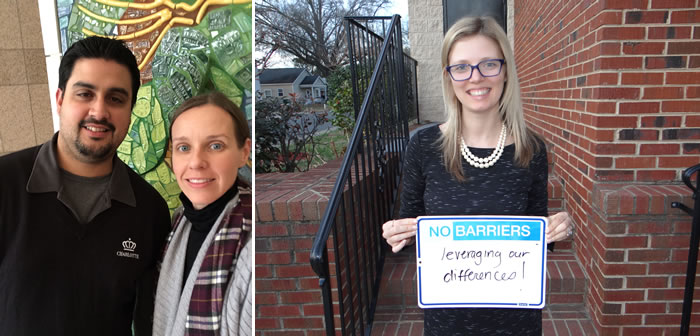
It’s a great thing when community engagement is a primary focus of many organizations. However, the challenge for some may be changing the engagement status quo into what it can be in the future. With the abundance of tools available and the desire to do more engagement, there is an opportunity for creativity and innovation. So, how does this all come together to build something that can impact not only a community but those in public service as well?
For local government, employees at all levels across an entire organization can play a key role in developing new ways to engage the public. Four city of Charlotte employees were recently selected as finalists in the Knight Cities Challenge, a national call for new ideas that would make communities a better place to live and work. Two of the employee ideas focused on engaging the community in a very unique way.
The employees are pictured above: Charlotte-Mecklenburg Storm Water Services, Alyssa Dodd – in the left photo, with Carlos Alzate; and Sarah Hazel (holding the “No Barriers” sign).
Alyssa’s idea is centered around city employees taking 10 minutes once a week to have a conversation with a member of the community to discuss how we can make our city a better place to live, work and play. Just think, if every employee did this, we could collectively engage more than 364,000 people a year in one-on-one conversations. These conversations could lead to new relationships being formed with the community and have a lasting impact on the employees who participate. The city could gain new perspectives and fresh ideas from residents. In turn, residents could feel a stronger connection to the city and its employees.
A second idea focused on working with the community to leverage physical barriers between diverse communities to create a dynamic common space for neighborhoods. Many of these barriers are spaces that have great potential, but may go unused and oftentimes disconnect the community. If people who are racially, socially, generationally or economically divided claim this space and work side by side with local government, it can become a safe and fun place. Sarah Hazel’s vision is for people working together to create the new, common space to break down negative perceptions abutting neighborhoods may have about each other. More specifically, the act of co-creating elements of the space can foster a sense of ownership and shared experience that builds pride and relationships for years.
In order to have successful engagement, you must develop a relationship with residents to understand what they are passionate about, how they currently interact with local government, and how they want their voice to be heard. For many people we find that social media is a huge draw. We have also learned there are a good number of residents who prefer to attend public meetings and receive mailers. Engagement cannot simply be a one size fits all approach. A tailored approach is necessary, but you have to know your community. You have to work on building bridges and seek input from diverse groups.
Take the barriers project again for example. Residents would be challenged to not only identify barriers, but also work with diverse groups to overcome the barriers by creating interactive art or designing elements of a park using light and sound. It is a way to take something that matters to residents and create something that brings the community together in a way they never thought was possible. Civic innovators are currently working with the No Barriers team to take this project from idea to execution.
Imagine if unique ideas such as these were implemented or even tested throughout communities across the country. Imagine if we challenged those around us to engage at a higher, more meaningful level. As a result, more relationships would be cultivated, greater trust would be built and there would be a significant increase in sense of community. If we dared to think differently, the positive impact would certainly be worth stretching the bounds of community engagement.
Click here to learn more about the ideas submitted for the Knight Cities Challenge.